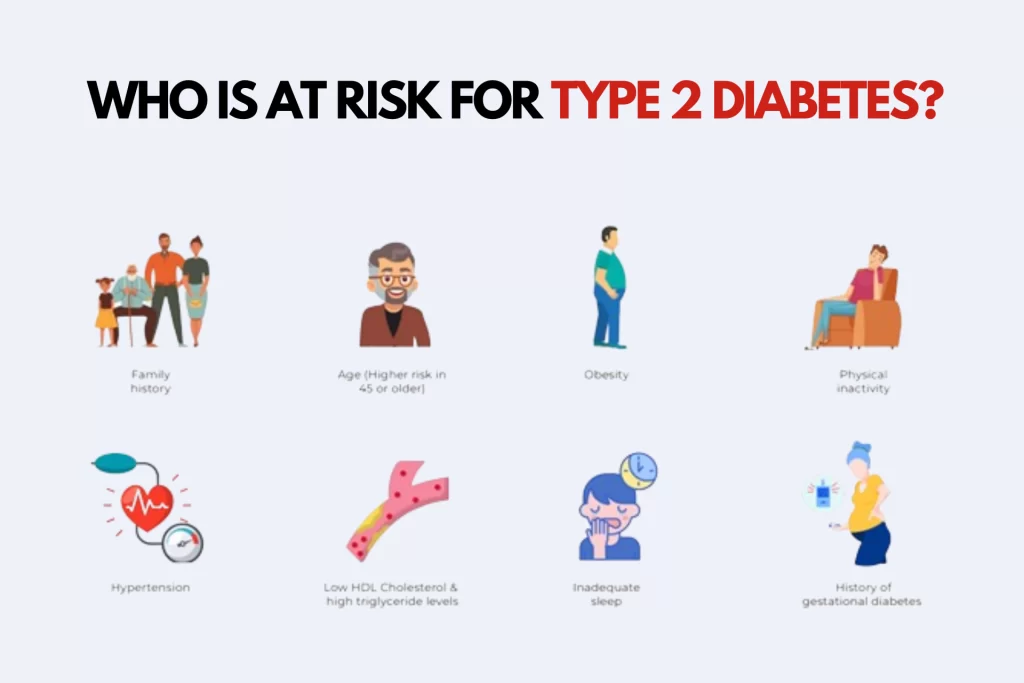Type 2 diabetes is a prevalent and potentially serious condition that affects millions of people worldwide. Understanding who is at risk for type 2 diabetes is crucial for early detection, prevention, and effective management of the disease. By identifying key risk factors and promoting awareness, individuals can take proactive steps to reduce their risk and lead healthier lives.
Table of Contents
What is the meaning of type 2 diabetes
Type 2 diabetes is a chronic metabolic disorder characterized by high blood sugar levels due to insulin resistance or inadequate insulin production. Insulin, a hormone produced by the pancreas, helps regulate blood sugar levels by facilitating the absorption of glucose into cells for energy. In type 2 diabetes, cells become resistant to insulin’s actions, leading to elevated blood sugar levels. Over time, this can result in serious complications such as cardiovascular disease, nerve damage, kidney problems, and vision impairment.
Who is at Risk for Type 2 Diabetes?

Several factors can increase the risk of developing type 2 diabetes, including:
1. Obesity: Excess body weight, particularly abdominal obesity, is one of the most significant risk factors for type 2 diabetes. Being overweight or obese can lead to insulin resistance, making it harder for the body to regulate blood sugar levels effectively.
2. Family History: Individuals with a family history of diabetes are at a higher risk of developing the condition themselves. Genetics can play a significant role in determining susceptibility to type 2 diabetes, although lifestyle factors also contribute to its onset.
3. Age: The risk of type 2 diabetes increases with age, particularly after the age of 45. As people get older, their risk of developing diabetes rises, partly due to changes in metabolism and decreased physical activity.
4. Physical Inactivity: Leading a sedentary lifestyle with little or no regular physical activity can significantly increase the risk of type 2 diabetes. Exercise helps improve insulin sensitivity and promotes weight loss, both of which are crucial for diabetes prevention.
5. Unhealthy Diet: Poor dietary habits, such as consuming high amounts of processed foods, sugary beverages, and refined carbohydrates, can contribute to weight gain and insulin resistance, increasing the risk of type 2 diabetes.
6. Ethnicity: Certain ethnic groups, including South Asians, Africans, Hispanics, and Indigenous populations, are at a higher risk of developing type 2 diabetes compared to others. This increased risk may be due to a combination of genetic, cultural, and environmental factors.
7. Gestational Diabetes: Women who have had gestational diabetes during pregnancy are at an increased risk of developing type 2 diabetes later in life. Additionally, children born to mothers with gestational diabetes may have a higher risk of developing diabetes themselves.
8. Polycystic Ovary Syndrome (PCOS): Women with PCOS, a hormonal disorder characterized by irregular periods, excess hair growth, and polycystic ovaries, are at a higher risk of developing insulin resistance and type 2 diabetes.
How to Control Type 2 Diabetes – Must Watch the Video
Preventing Type 2 Diabetes
While certain risk factors for type 2 diabetes, such as age and family history, cannot be changed, there are steps individuals can take to reduce their risk and prevent the onset of the disease. Making healthy lifestyle choices is key to diabetes prevention. Here are some strategies to consider:
1. Maintain a Healthy Weight: Aim to achieve and maintain a healthy weight through a balanced diet and regular physical activity. Losing even a small amount of weight can significantly reduce the risk of type 2 diabetes.
2. Eat a Balanced Diet: Focus on consuming a variety of nutrient-rich foods, including fruits, vegetables, whole grains, lean proteins, and healthy fats. Limit your intake of sugary foods, refined carbohydrates, and processed foods.
3. Stay Active: Engage in regular physical activity, such as brisk walking, cycling, swimming, or dancing, for at least 150 minutes per week. Incorporate strength training exercises to build muscle and improve insulin sensitivity.
4. Monitor Blood Sugar Levels: If you have risk factors for type 2 diabetes or are concerned about your health, consider monitoring your blood sugar levels regularly. Early detection and intervention can help prevent or delay the onset of diabetes.
5. Get Regular Check-ups: Visit your healthcare provider regularly for check-ups and screenings. They can assess your risk factors for type 2 diabetes and provide personalized recommendations for prevention and management.
How to Control Type 2 Diabetes – Must Watch the Video
Conclusion – Who is at risk for type 2 diabetes
In conclusion, type 2 diabetes is a complex and potentially serious condition that affects individuals from diverse backgrounds. By understanding the risk factors associated with type 2 diabetes and taking proactive steps to address them, individuals can reduce their risk and lead healthier lives. Through healthy lifestyle choices, regular physical activity, and regular medical care, it is possible to prevent or delay the onset of type 2 diabetes and its associated complications. By promoting awareness and empowering individuals to take control of their health, we can work towards a future where type 2 diabetes is less prevalent and its impact on individuals and communities is minimized.
Frequently Asked Questions
Who is most at risk for type 2 diabetes?
You have an increased risk of type 2 diabetes if you:
- If you have prediabetes.
- If you are overweight person.
- If you are 45 years or older.
- In your family, if you have a parent, brother or sister with type 2 diabetes.
- If you are physically active less than 3 times a week.
- If you have ever had gestational diabetes or given birth to a child who weighed more than 9 pounds.
- If you are African American, Hispanic, Latino, American Indian or Alaska Native. Some Pacific Islanders and Asian Americans are also at higher risk.
- If you have non-alcoholic fatty liver disease, you may also be at risk for type 2 diabetes.
How to Control Type 2 Diabetes – Must Watch the Video
Who usually has type 2 diabetes?
Type 2 diabetes can affect individuals of all ages, ethnicities, and backgrounds, but certain groups are more commonly affected than others. Typically, type 2 diabetes is more prevalent among adults, particularly those over the age of 45. However, due to rising obesity rates and sedentary lifestyles, there has been an alarming increase in type 2 diabetes cases among younger populations, including adolescents and young adults.
What is the main cause of type 2 diabetes?
The main cause of type 2 diabetes is insulin resistance. Insulin resistance occurs when the cells in your muscles, fat and liver don’t respond to insulin as they should. Insulin is a hormone produced by your pancreas that is vital to regulate blood sugar levels.
Who is the most common victim of type 2 diabetes?
Type 2 occurs more frequently in older adults. But the increasing number of children with obesity has led to more cases of type 2 diabetes in younger people. There is no cure for type 2 diabetes. Losing weight, eating a healthy diet and exercising can help to control the disease.
How to Control Type 2 Diabetes – Must Watch the Video




